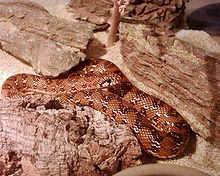- Mole snake
-
Not to be confused with Mole viper.
Mole snake Scientific classification Kingdom: Animalia Phylum: Chordata Class: Reptilia Order: Squamata Suborder: Serpentes Family: Colubridae Genus: Pseudaspis Species: P. cana Binomial name Pseudaspis cana
(Linnaeus, 1758) Distribution of the Mole snake
Distribution of the Mole snakeThe mole snake (Pseudaspis cana) is a species of snake in the family Pseudaspididae. It is native to much of southern Africa, and is the only member of the genus Pseudaspis. A study showed that P. cana are caught and consumed by the honey badger, among other species. Remains of the mole snake were found in the faeces, and suggest that the consumed individuals were larger specimens.[1]
Contents
Taxonomy
P. cana was originally described by Linnaeus in 1758. Its original binomial name was Coluber cana. Since then, it has also been known as Coronella cana (Duméril, Bibron, & Duméril, 1854), before being reclassified Pseudaspis cana (Boulenger, 1893).[2] P. cana is the only species in genus Pseudaspis.
Description
The mole snake can grow to lengths of up to 2 metres (6 ft 7 in).[3] A small head and pointed snout are said to be characteristics of the species.[4] It has a firm, tubular body. Like the majority Colubrinae, P. cana is non-venomous.
In mature individuals, the body is mostly one colour, and may vary from yellow to brown to grey, and in some cases, solid black.[3] The young have dark markings and spots that are gradually lost as the individual ages.[4] Colour may be related to geography; in the south, most specimens are black whereas specimens found in the northern part of their range are brown, reddish brown, grey or yellow.
Diet
The primary food source of P. cana comprises golden moles (hence the name), rodents, and other small mammals.[4][5] For this reason, it is considered useful for the natural control of problem rodents.
Its diet may also include the eggs of seafowl. At Robben Island, mole snakes were observed eating the eggs of Spheniscus demersus (African penguin), Larus hartlaubii (Harlaub's gull), and Numida meleagris (helmeted Guinea-fowl). Juveniles were observed eating Strongylopus grayii (clicking stream frogs).[6]
The Mole snake is a nest predator of the Karoo prinia. P. cana is one of at least six snake species which cause reproductive loss and decrease of nest success in the Karoo prinia.[7]
Distribution and habitat
The range of P. cana encompasses most of southern Africa.[3] P. cana is common in Kalahari Gemsbok National Park.[4] It is widely distributed, with a range stretching from Angola in the north to Kenya in the east to South Africa.
Mole snakes live in the abandoned burrows of other animals. They can be found in a variety of habitats, such as the scrublands of the South African Cape and the Highveld plateaux and grasslands. Mole snakes have also been found in mountainous and desert areas.[5]
In captivity
The mole snake can be "quite ferocious".[5] Though not venomous, they can cause severe bite wounds. Despite this, they are said to make good pets when sufficiently settled.[5]
References
- ^ Kruuk, H.; M. G. L. Mills (1983). "NOTES ON FOOD AND FORAGING OF THE HONEY BADGER Mellivora capensis IN THE KALAHARI GEMSBOK NATIONAL PARK". Koedoe. http://koedoe.co.za/index.php/koedoe/article/view/595/624. Retrieved 25 January 2010.
- ^ "Pseudaspis cana". REPTILES DATABASE. J. Craig Venter Institute. http://jcvi.org/reptiles/species.php?genus=Pseudaspis&species=cana. Retrieved 23 January 2010.
- ^ a b c Skubowius, Bernd (6 January 2008). "Keeping of the African Mole Snake". Pinesnake.de. http://www.pinesnake.de/english/other/pseudaspis.html. Retrieved 23 January 2010.
- ^ a b c d Fitzsimons, V.; C. K. Brain. "A SHORT ACCOUNT OF THE REPTILES OF THE KALAHARI GEMSBOK NATIONAL PARK". pp. 102–103. http://www.koedoe.co.za/index.php/koedoe/article/viewFile/867/993. Retrieved 25 January 2010.
- ^ a b c d Junker, K.; E P Laneb, B Dlaminib, A Kotzeb, and J Boomker. "Post mortem identification of Kalicephalus colubri colubri (Nematoda: Diaphanocephalidae) in a captive Mole snake (Pseudaspis cana) in South Africa". https://repository.up.ac.za/upspace/bitstream/2263/10479/1/Junker_Post%282009%29.pdf. Retrieved 25 January 2010.
- ^ Dyer, B.M. (June 1996). "Predation by snakes on seabirds at three South African islands (Abstract)". South African Journal of Marine Science. NISC Pty Ltd. http://www.ingentaconnect.com/content/nisc/sajms/1996/00000017/00000001/art00029. Retrieved 25 January 2010.
- ^ Nalwanga, Dianah; Penn Lloyd, Morné A du Plessis and Thomas E Martin (2004). "The influence of nest-site characteristics on the nesting success of the Karoo Prinia (Prinia maculosa)". Ostrich. South Africa: NISC Pty Ltd. http://umt.edu/mcwru/files.pdf/Tom's%20PDF/Influence%20of%20nestsite%20characteristics2004.pdf. Retrieved 25 January 2010.
Categories:- Reptiles of Africa
- Pet snakes
- Reptiles of South Africa
Wikimedia Foundation. 2010.

